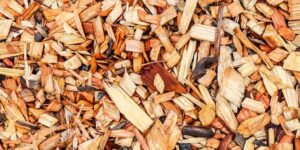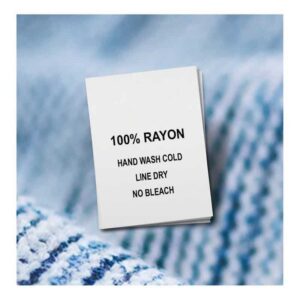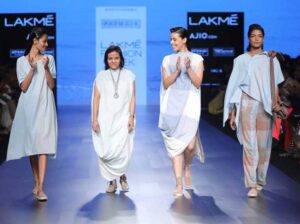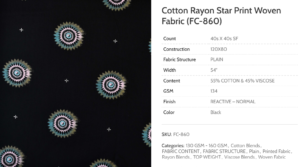Rayon is a type of fabric made from plant cellulose.
The term “rayon” is a generic name, and the different types of rayon vary in terms of the manufacturing process, fiber properties, and applications.
For example, viscose rayon is the most common type of rayon, while cupro is a less common variant.
Each type of rayon has its own benefits and drawbacks that you should be aware of before making a purchase.
In this blog post, we’ll discuss the different types of rayon, including Viscose rayon and Cupro.
What is Viscose Rayon?
Viscose rayon is the most common type of rayon.
It’s made from cellulose obtained from wood pulp or cotton linters.
The raw material is processed using chemicals, such as caustic soda and sulfuric acid, to dissolve the cellulose fibers.
After the cellulose has been dissolved, it’s extruded through spinnerets into a thin, continuous filament.
This filament is then stretched to make it stronger and give it a more uniform diameter.
The process of spinning the fibers into yarns, weaving the yarns into fabric, and finishing the fabric with dye or print gives viscose rayon its distinctive feel.
It’s soft, smooth, and comfortable to wear because of its cotton-like appearance and feels.
However, like other types of rayon, viscose rayon has a tendency to pill over time. It also tends to wrinkle easily.

Viscose rayon is made from trees, and some people are concerned about the environmental impact of using it.
However, viscose rayon uses a small fraction of the energy required to make cotton or polyester, and it’s completely biodegradable.
It’s often blended with other fibers to make it stronger and more resistant to wrinkling.
Blended fabrics include blends of viscose rayon and cotton, or viscose rayon and polyester.
Viscose rayon is soft, comfortable, lightweight, and absorbent. It’s used in underwear, tights, linings for jackets and pants, gloves, swimwear, stockings, bedding (including sheets), some medical garments (such as catheters), some hosiery, and in some children’s clothing.
Because it is often blended with other fibers, you’ll need to check the garment label for the fiber content. The material is also sometimes sold as rayon or modal.
If you’re sensitive to rayon, you may be able to wear viscose rayon if it’s blended with cotton or polyester. If you’re allergic to both rayon and cotton, a blend of viscose rayon and polyester may be a good choice.
Viscose rayon can be dyed with both acid and basic dyes.
The fibers are often blended with other fibers before they’re dyed, so you’ll need to check the label for information about the fiber content of the garment.
A garment containing viscose rayon will be labeled as such.
If the label doesn’t say “viscose,” it probably isn’t made of this material.
Cotton/Viscose Rayon Blends
If you’re allergic to cotton, you may be able to wear garments made from a blend of cotton and viscose rayon. The amount of cotton in the blend is important: The more cotton there is, the less likely it is that you’ll have a reaction.
The fabric should be labelled as containing cotton and viscose rayon, or say “allergy-free” on the label.
A small amount of polyester is usually added to make the fabric easier to care for and prevent shrinkage.
Polyester itself isn’t likely to cause an allergic reaction, but it may be listed on the label as part of the blend (for example, “cotton/viscose rayon/polyester”). The U.S.Food and Drug Administration (FDA) has determined that polyester/cotton blends do not require allergy labeling.
However, if the product contains any other allergenic fiber, such as wool or silk, it must be labeled as “contains wool” or “contains silk.”
Caring for rayon clothing

The care label on a garment made of viscose rayon will recommend washing in warm water and drying on a medium setting.
If you choose to dry-clean your viscose rayon clothing, be sure to choose a solvent that is free of chlorine and perchloroethylene.
Chlorine bleach should never be used on viscose rayon.
Read more about care labels
Dry cleaning is generally not recommended for viscose rayon clothing.
In some cases, garments that are labeled as dry clean only can be hand washed or machine washed in a lingerie bag on the gentle cycle.
If you choose to wash your viscose rayon clothing, it’s best to avoid putting it in the dryer.
When the garment is still damp, place it flat on a drying rack and allow it to air dry completely before wearing.
What is Cupro Rayon?
Cupro rayon is a fabric made from a blend of cupro and rayon.
Cupro is a plant-based fiber made from the cotton linter, which is the soft, silky fiber that sticks to the seeds of the cotton plant.
Rayon is a synthetic fiber made from cellulose, which is a natural polymer found in trees and plants.

Cupro rayon is a durable and absorbent fabric that feels cool and smooth to the skin.
It drapes well and resists wrinkling, making it a good choice for everyday clothing items like blouses, skirts, and pants.
In addition to its natural fibers, cupro rayon can also be blended with other fibers like wool and silk.
It is also used in home decor items like bedding, draperies, and upholstery.
The different types of cupro rayon fabric include:
Lightweight Cupro Rayon Fabric: This type of fabric is usually used for lingerie, blouses, and tops. It is also used in clothing that needs to be light-weight.
Heavyweight Cupro Rayon Fabric: This type of fabric is usually used for dresses, jackets, coats, and pants. It can also be used for a lot of home décor items such as curtains and upholstery. The weight of this fabric makes it easy to iron without any wrinkles.
Conclusion
Rayon fabric has high demand in the market for its versatile use cases.
It is biodegradable but not as sustainable as cotton even though it uses less electricity.
Rayon requires normal care while washing.
Some of the blended rayon fabrics are non-allergic.
For Rayon fabrics, contact us.
















